Effective Strategies to Eliminate Black Ants
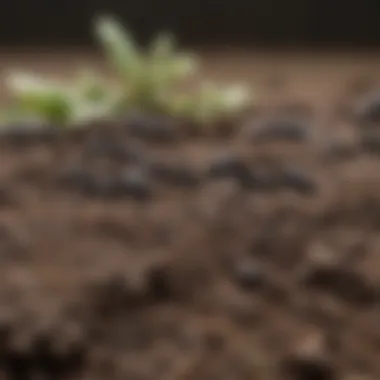
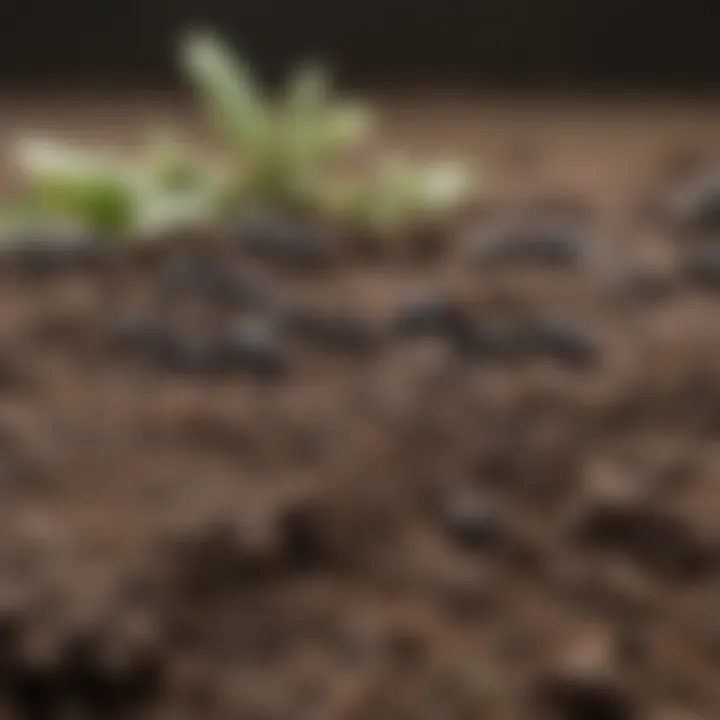
Intro
Black ants, particularly species such as Lasius niger, can make their presence known in gardens and yards. These ants are often harmless but can become a nuisance when they invade outdoor living spaces. Understanding their behavior, the reasons for their presence, and effective removal methods is essential for homeowners who want to maintain a pleasant yard. This article provides a comprehensive guide to eliminating black ants safely and effectively.
It covers their habits, why they appear, and the both natural and chemical solutions to deal with infestations. Additionally, proper preventive measures play an important role in keeping these pests at bay. By understanding black ants and how to manage them, homeowners can enjoy a more comfortable outdoor experience.
Understanding Black Ants
Black ants exhibit complex social structures. They work together in colonies, which can range from dozens to thousands in number. They typically establish nests in soil, alongside foundations, or under debris. Their primary role involves foraging for food and defending their nest.
Reasons for Infestation
Infestations often arise when there is an available food source that attracts these ants. Common attractants include:
- Sugar-rich substances such as fruits or spilled drinks
- Pet food left outside
- Waste from gardens, including decaying plant matter
Additionally, moist areas provide ideal nesting locations, prompting ants to invade yards in their pursuit of shelter and sustenance.
Black ants are often simply responding to the environmental conditions and available resources in a yard.
Strategies for Elimination
The methods for eliminating black ants can be broken down into two categories: natural and chemical.
Natural Methods
Natural elimination methods are typically preferred for those looking to avoid harsh chemicals. Some effective strategies include:
- Boric Acid: This substance can be mixed with sugar and water to create an enticing bait for the ants. When consumed, it disrupts their digestive system, leading to a decline in the colony's population.
- Diatomaceous Earth: Sprinkling food-grade diatomaceous earth around suspected entry points can help trap and kill ants. It works by damaging their exoskeletons, resulting in dehydration.
- Vinegar Solution: Mixing equal parts vinegar and water can serve as an effective repellent. Spraying this mixture around entry points and nests can deter ants from entering your yard.
Chemical Solutions
For those who prefer quicker results, chemical methods can be employed. Options include:
- Ant Baits: These attract ants, which then carry the poison back to their colony, eventually killing the queen and others.
- Insecticide Sprays: Targeting nests with a spray can provide immediate relief, but caution is advised, especially around children and pets.
Prevention
Preventing a black ant infestation is often more effective than dealing with an established colony. Key prevention tips include:
- Sealing cracks and gaps in your home’s foundation and walls.
- Keeping the yard clean by promptly removing fallen fruits and debris.
- Cleaning outdoor eating areas to eliminate food residue.
By implementing these strategies, it is possible to maintain a yard free from the intrusion of black ants, contributing to an overall healthier outdoor environment.
Finale
Successfully eliminating black ants requires a combination of knowledge and action. By understanding their behavior and employing both natural and chemical strategies, homeowners can effectively manage their presence. Continual maintenance and preventive measures ensure that your yard remains a welcoming, pest-free space.
Understanding Black Ants
Understanding black ants is crucial for effective management and elimination strategies. These ants can thrive in various environments and may pose risks to gardens and overall outdoor enjoyment. Homeowners need to have a comprehensive insight into the biology and behavior of black ants to develop informed approaches to control them. Recognizing how these ants function and where they prefer to dwell allows for targeted treatments that are both effective and minimally invasive.
Biology and Behavior
Black ants belong to various species, commonly the Lasius niger and Monomorium minimum. They are known for their structured social systems, which include distinct roles within their colonies. Understanding their reproductive cycles enhances control methods. For instance, worker ants are primarily foraging for food, while the queen focuses on reproduction. This knowledge assists in selecting appropriate control measures.
The behavior of these ants can fluctuate based on environmental conditions. They typically become more active during warmer months, seeking food and resources. Ants communicate using pheromones, making it easier for them to navigate and locate food sources. By recognizing their communication methods, one can efficiently disrupt their activities to decrease their numbers in your yard.
Habitat Preferences
Black ants prefer moist and sheltered habitats. They commonly inhabit areas with plenty of organic matter such as leaf litter, mulch, or wood piles. Identifying potential nesting sites is essential. These ants also have a tendency to invade homes, especially in search of food. This nesting behavior can lead them to your garden as they seek sugar and protein-rich substances.
Furthermore, black ants often thrive in disturbed environments where human activity creates opportunities. This includes areas under stones, within rotting wood, or even directly in soil. Homeowners should examine their yards for these conditions and take corrective measures to eliminate potential nesting sites.
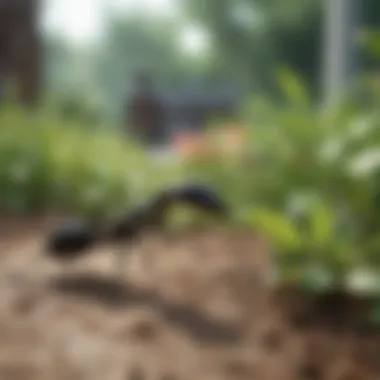

In summary, a deep understanding of black ants' biology and habitat preferences lays the groundwork for effective management strategies. Without this foundation, efforts to eliminate them may prove ineffective or temporary. Taking proactive steps based on this knowledge can considerably enhance the health of your outdoor space.
"Knowing how ants live and behave enables better strategies for managing their populations in yards and gardens."
By continually assessing these factors, homeowners can maintain a balance that discourages black ants from becoming a nuisance.
Identifying Infestations
Identifying infestations is a crucial step in managing black ants in your yard. Recognizing the signs that indicate their presence allows you to take timely action. This can save your garden from potential damage and minimize the discomfort that comes from having these pests in your outdoor space. Homeowners can benefit significantly from understanding how to spot these signs early.
Signs of Presence
One of the most effective ways to identify black ant infestations is by observing specific signs of their activity. Look for the following indicators:
- Ant Trails: Black ants often follow well-established paths to and from food sources. These trails can often be seen on sidewalks, patios, or near plant beds.
- Nesting Sites: You may notice mounds of soil or small holes in the ground, which can signify an ant nest. These nests might be located in areas with loose soil or under stones.
- Foraging Behavior: If you notice black ants carrying food back to their nests, it’s a clear indication of an infestation. Common food sources include honeydew from aphids or sugary residues.
- Presence of Dead Ants: Finding dead ants can also indicate the population size. If you see more than a few, it could reflect a larger problem.
"Early detection of black ants can prevent larger infestations in the future. Observing their behavior is key."
These signs will help you gauge the severity of the infestation. If detected early, it can help find the most suitable control methods.
Common Nesting Sites
Understanding where black ants prefer to build their nests is essential for effectively eliminating them. Typical nesting sites include:
- Underground: Many black ant species create nests underground in gardens and yards. The nests might be shallow or deep, depending on the species and environmental conditions.
- Moist Areas: Black ants are often found in damp locations where food sources are plentiful. Areas around plant beds, under mulch, or near water features are common.
- Wood Structures: Some species may also nest in rotting wood or inside wooden structures. If you have wooden decks or fences, inspect them for signs of activity.
- Cracks and Crevices: Black ants readily exploit cracks in pavement or foundation walls. These areas can serve as protective entry points for nests.
By knowing these nesting preferences, you can target your efforts better. Monitoring these areas will help develop a more effective strategy for removal, leading to a healthier yard.
Assessing the Impact
Assessing the impact of black ants in your yard is crucial for maintaining the health of your outdoor space. These ants, while often overlooked, play a significant role in the ecosystem. However, their presence can also lead to various complications that affect gardening and outdoor activities. Understanding these impacts allows homeowners to make informed decisions about control and prevention methods.
When it comes to gardens, black ants can have both positive and negative influences. On one hand, they help in breaking down organic matter and aerating soil, which can benefit plant growth. On the other hand, their tendency to protect aphids can lead to damage in plants, restricting their growth and yield. Therefore, homeowners should evaluate the specific risks associated with black ant infestations before taking further steps.
Potential Risks to Gardens
Black ants can introduce several risks to your garden environment. Here are key concerns:
- Damage to Plants: Black ants often tend and farm aphids, which damage plants by sucking sap. The more aphids present, the more potential harm to the plants.
- Competition for Resources: As ants invade, they can compete with beneficial insects for resources such as food and space, possibly hindering their effectiveness in pollination or pest control.
- Structural Interference: Ants build their nests underground, which can disturb the roots of plants or cause soil erosion in certain areas.
- Infestation Escalation: Ignoring the initial signs of ant presence can lead to larger infestations. This can result in more extensive damage, making control efforts more complicated and costly.
"Addressing the ants early can save the plant life in your yard from irreversible damage."
Effects on Outdoor Activities
The presence of black ants can also have significant effects on outdoor activities. Residents might notice some of these aspects:
- Reduced Enjoyment of Outdoor Space: A heavy ant presence can deter people from enjoying their yards, reducing the appeal of outdoor spaces for family gatherings or parties.
- Potential for Stings: While black ants are generally not aggressive, they can bite. For sensitive individuals, bites can cause discomfort, leading to an aversion to outdoor activities.
- Hygiene Concerns: Ants can invade outdoor dining areas or barbecues, raising sanitation issues that make enjoyable gatherings less appealing.
- Disruption of Landscaping Projects: Any ongoing outdoor project can be hindered by the presence of these ants, making it difficult to carry out landscaping effectively.
Assessing the impact of black ants should be an integral part of managing your yard. By understanding their potential risks, you can take effective action to protect your garden and maintain harmony in your outdoor space.
Natural Elimination Methods
Natural elimination methods are critical for managing black ants without relying solely on chemical solutions. Many homeowners prefer these methods due to their lower environmental impact and safety. They can provide effective results while minimizing harm to beneficial insects and the ecosystem. Additionally, natural methods can often be more cost-effective and accessible than commercial products, making them valuable tools for anyone dealing with ant issues.
Diatomaceous Earth
Diatomaceous earth (DE) is a naturally occurring substance made from the fossilized remains of tiny aquatic organisms called diatoms. When used correctly, it can be an effective tool in controlling black ants. DE works by damaging the ants’ exoskeletons, leading to dehydration and death.
When applying diatomaceous earth, consider these points:
- Application: Spread it in areas where you notice ants, focusing on their trails and near potential entry points. A thin layer is usually enough.
- Safety: DE is safe for pets and humans, as it is non-toxic, but it's advisable to avoid inhaling the dust.
- Moisture: It is crucial to keep DE dry. If it becomes wet, it loses its effectiveness. Reapply after rainfall or watering to maintain control.
Vinegar Solutions
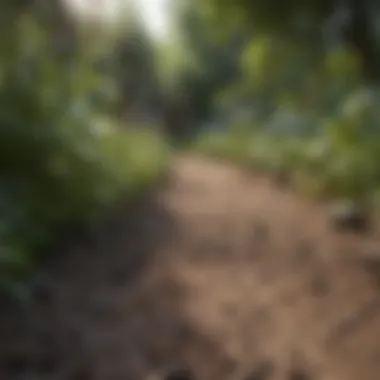

Using vinegar is another natural strategy to target black ants. The acetic acid in vinegar disrupts ant pheromone trails, making it difficult for them to communicate and navigate. This can deter them from returning to certain areas.
Here’s how you can use vinegar effectively:
- Mixing Solution: Combine equal parts of water and white vinegar in a spray bottle.
- Application: Spray directly onto ant trails, nests, or areas where you see ant activity. Cleaning surfaces with this solution can help erase pheromone traces.
- Scent: While the vinegar smell dissipates, remember that it may not be appealing during application.
Essential Oil Repellents
Essential oils such as peppermint, tea tree, and orange oil have strong scents that repel ants. They can be used as part of a natural approach to keep black ants at bay without causing harm to the environment.
To use essential oils effectively:
- Make a Mixture: Combine a few drops of your chosen essential oil with water in a spray bottle.
- Spray Areas: Apply the mixture around entrances, nest sites, and along ant trails. Regular application ensures continued effectiveness.
- Test for Sensitivity: If you have pets, be mindful of certain oils that may not be safe for them. Research each oil before use.
Natural elimination methods not only provide ant control but also contribute positively to maintaining a balanced garden ecosystem.
These techniques outlined above demonstrate how effective natural solutions can be in dealing with black ants. By combining methods, you can enhance the chances of success, creating a healthier outdoor environment.
Chemical Control Options
When it comes to controlling black ants, chemical options can be quite effective. Understanding how to utilize these methods properly is important for both effectiveness and safety. They can serve as a decisive approach especially in cases of significant infestation. If natural methods do not yield the desired results, turning to chemical solutions may be necessary.
Insecticide Baits
Insecticide baits are a commonly used method for ant control. These baits are designed to attract ants while delivering a lethal dose of insecticide. The key benefit of using baits is that ants take the poison back to their colony. Ingesting the bait allows the insecticide to spread through the entire colony, effectively reducing the population.
Using baits has some advantages:
- Targeted approach: Baits lure ants, so they mainly affect the targeted pest, sparing beneficial insects.
- Reduced pesticide exposure: Baits are usually contained in specific locations, limiting human and environmental exposure to harmful chemicals.
- Long-lasting effects: Once ants bring the bait back to their nest, it continues to eliminate other ants over time.
However, careful consideration is necessary. Not all baits work the same way. Some may be slow-acting, allowing ants to keep foraging for days. Reading labels and following instructions is critical when using these products.
Granular Insecticides
Granular insecticides offer another chemical control option. These are solid particles that can be spread across the yard. When ants come into contact with or ingest these granules, they are exposed to insecticides that can control their population.
There are several reasons to consider granular insecticides:
- Ease of application: Granular products are typically simple to apply and can cover a large area.
- Immediate impact: Many granular insecticides provide quick results, as they can kill ants upon contact.
- Versatility: These products can be applied to various locations, including nests and trails.
When using granular options, it is crucial to check the affected areas regularly. This ensures any leftover bait does not harm pets or wildlife. Always follow the manufacturer's guidelines for safe application.
Chemical control methods, when used responsibly, can provide effective solutions to black ant infestations. Each method has its strengths, but they also require proper understanding and application to maximize their benefits.
Steps for Implementation
Preparing Your Yard
Before taking any action, assessing your yard is vital. Begin by identifying areas where black ants frequently appear.
- Clear Clutter: Remove any debris, such as piles of leaves, old wood, or discarded containers, as these structures provide shelter for ants. Keep your garden tidy.
- Check for Moisture: Ants are attracted to water sources. Fix any leaky pipes or hoses. Ensure that your gutters are clean and functional to prevent water accumulation.
- Trim Vegetation: Keep shrubs and bushes away from the house. When plants touch your home, they can provide a pathway for ants.
By preparing the yard properly, you eliminate favorable conditions for black ants. This creates a less inviting environment before implementing chemical or natural methods.
Applying Control Methods
After preparation, the next crucial step involves the strategic application of control methods. Choose approaches based on your preferences and situation. Both natural and chemical solutions can be effective in this phase:
- Natural Solutions: As mentioned previously, options like diatomaceous earth, vinegar solutions, and essential oil repellents can be used.
- Chemical Options: If necessary, consider using insecticide baits or granular insecticides. Follow the guidelines closely when applying these products to ensure safety and effectiveness. Make sure to:
- Apply baits near ant trails and nests.
- Wet the ground before applying granular insecticides to enhance effectiveness.
Remember, proper application is crucial for reducing the black ant population in your yard.
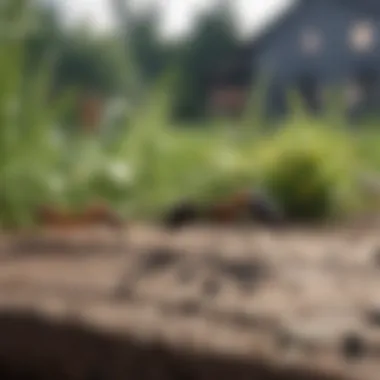

Monitoring Effectiveness
Once the control methods are in place, it is essential to monitor their effectiveness. This process ensures that the strategies are working as intended and highlights areas that may need further attention. Here are steps for effective monitoring:
- Regular Inspections: Check your yard periodically. Look for ant activity and potential new trails. If you spot a resurgence, further action may be required.
- Assess Nesting: Monitor common nesting sites within your yard. If nests continue to persist, consider adjusting your approach based on observed patterns.
- Document Changes: Keep notes on any changes in ant behavior. This documentation can guide you in adjusting your methods or re-evaluating the situation if necessary.
Effective monitoring is not just about observing; it is also about adapting strategies based on what you learn during this phase.
By adhering to these steps in implementation, homeowners can increase their chances of effectively eliminating black ants while maintaining a safe and healthy outdoor environment.
Long-term Prevention Strategies
Long-term prevention strategies are essential in managing black ant populations in your yard. Unlike immediate solutions, which may only address the symptoms of an infestation, these strategies focus on altering conditions that allow ant colonies to thrive. Implementing long-lasting methods can save homeowners from recurring problems, reducing the need for repeated treatments. Ensuring that your outdoor space remains unattractive to these pests not only addresses their presence but also helps protect your garden and yard health.
Maintaining a Clean Yard
A clean yard is a first line of defense against black ants. Ants are often attracted to debris and food sources that are present in cluttered spaces. Regularly mowing the lawn, cleaning up fallen leaves, and removing any excess organic matter can significantly deter ants.
- Remove food scraps and trash: Ensure that no food residues are left outside. Even pet food can attract ants.
- Prune overgrown vegetation: Trim bushes and trees that can provide shelter or paths to your home.
- Clear debris: Get rid of old containers, wood piles, and any other items that might create hiding spots.
Eliminating Attractants
Identifying and removing attractants is a key step in preventing infestations. Black ants are drawn to food, moisture, and shelter. Therefore, creating an environment that lacks these essentials is crucial.
- Food sources: Store any outdoor food securely and away from ants. Use tight-sealing containers for birdseed, pet food, and other edibles.
- Moisture control: Fix any leaks in hoses, watering systems, or around the house. Ants need water to survive, so reducing moisture can drive them away.
- Manage compost properly: If you use compost bins, ensure they are adequately maintained. Too much food waste can attract ants.
Physical Barriers
Physical barriers can also be effective in preventing black ants from entering certain areas of your yard or home. These barriers can include:
- Mulching: Use non-attractive mulches that are less inviting for ants, such as rubber or stone.
- Ant baits: Place bait stations around the perimeter of your yard. These baits can attract and help reduce ant populations before they enter your home.
- Sealing entry points: Inspect and seal any cracks or openings in your home. Ants can enter through small spaces, so thorough maintenance is necessary.
"An ounce of prevention is worth a pound of cure." By implementing these long-term strategies, homeowners can minimize the chances of black ants becoming a recurring issue in their yards.
When to Seek Professional Help
Dealing with black ants in your yard can be a tricky situation for many homeowners. While some infestations can be managed using do-it-yourself methods, there are instances when professional assistance is necessary. Understanding when to take that step can save time and resources. Relying solely on home remedies might not effectively eliminate a severe ant problem. Professionals have access to specialized equipment and treatments that can address the issue more comprehensively.
Signs of Severe Infestation
Recognizing signs of severe infestation is crucial in determining whether to seek professional help. Some of the key indicators include:
- Large Ant Trailers: If you notice numerous ants marching in a line towards a specific location, it is a strong indicator of a significant nest nearby.
- Visible Nests: Finding nests or mounds of soil near your home often suggests a large colony resides in your yard.
- Damage to Property: If you observe signs of damage to the structure of your home or your plants, this could mean that the infestation is more severe than initially thought.
- Frequent Encounters: An increase in the number of ants entering your living spaces can signal a colony that is expanding.
When these signs emerge, addressing the problem promptly is essential. Delay can lead to larger infestations, making the scenario more complicated and costly.
Evaluating Service Options
If you determine that professional pest control is needed, evaluating your service options becomes the next step. Not all services are equal. Consider the following factors while selecting a pest control service:
- Experience and Reputation: Look for services with a solid track record and positive reviews from customers. Longevity in the business often indicates reliable service.
- Methods Used: Inquire about the specific methods and products used by the company. Opt for those that employ environmentally friendly solutions when possible.
- Guarantees and Follow-up Services: Understand what guarantees the company offers. Following up with services can be beneficial, especially if the issue resurfaces.
- Cost and Estimates: Obtain estimates from multiple services to compare prices. Ensure you understand what services are included in the quoted price.
It is essential to approach pest control with a mindset of thoroughness. Inadequate treatment can lead to recurring problems.
End
Addressing the presence of black ants in your yard is crucial both for cosmetic reasons and the health of your garden. This article has laid out varied strategies to effectively eliminate these ants, emphasizing methods that harness safety and sustainability.
Recap of Effective Strategies
Reflecting on the techniques discussed, we find a balance between natural and chemical solutions. Here are some effective strategies:
- Natural Remedies: Using diatomaceous earth, vinegar, and essential oil repellents reduces reliance on harsh chemicals. These options are safer for pets and children.
- Chemical Control: For more extensive infestations, insecticide baits and granular insecticides offer focused solutions. These can be potent but should be used judiciously to minimize environmental impact.
- Long-term Prevention: Maintaining cleanliness and eliminating food sources prevent future infestations. Physical barriers can also deter the ants from entering designated areas of your yard.
Choosing the right method depends on the scale of the problem and personal preferences regarding chemical use. The integration of various approaches can increase effectiveness while promoting a healthy ecosystem.
The Importance of Sustainable Practices
Sustainable practices are vital for several reasons. Firstly, they create a healthier outdoor space, reducing the risk of chemical residues affecting plants, animals, and even water sources. Secondly, they contribute to the overall biodiversity in your yard, fostering an environment where beneficial insects can thrive.
Investing in sustainable methods, like organic repellents, not only fights ant infestations but also supports the ecological balance. Homeowners can take pride in knowing they are making a positive choice for their surroundings. This shifts the focus from mere eradication to fostering a harmonious relationship with nature.



